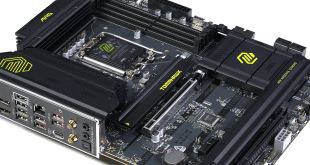We can see a fully black paint interior and there are 3 x 5.25″ and 7 x 3.5″ dive bays all configured for tool free operation. There are several cutout areas to route cables as well as an area for accessing the rear of the motherboard should we have to install a CPU back plate.
As we mentioned earlier the Shinobi is designed for a bottom mounted PSU. The 1st image above shows the mesh dust filter located below where the PSU sits. Directly in front of where the PSU sits there is a space for an optional 120mm intake fan. BitFenix have also provided a removable mesh dust filter for this area. As we look further up the back panel there are 2 holes provided for water cooling tubes which are protected by rubber grommets. There is 1 x 120mm rear mounted exhaust fan, one of the two fans which ship from the factory.
The top panel of the Shinobi is capable of holding an additional 2 x 120mm or 2 x 140mm exhaust fans. The 1st image above also gives a good indication of how large an area has been removed to allow access to the back side of the motherboard if we need to change cooling solutions. The next image shows us the drive bay configuration of the Shinobi. There are 8 x 3.5″ and 3 x 5.25″ bays which should be more then enough for most people. We can also see the 2nd 120mm fan that comes with the Shinobi. This fan draws cool air into the case and it gets expelled out the rear of the case.
BitFenix have also added a removable tray that can be used for a floppy drive, a hard drive, or an SSD depending on the demand.
We mentioned earlier that the Shinobi ships with 2 x 120mm fans. One serves as a front loaded intake fan while the other exhausts warm air out the rear of the chassis. BitFenix sent us over enough of their Spectre fans to test the Shinobi with a full compliment of fans. The Spectre fans are 12V, and draw .10A of power.
They operate at 1000 rpm(+/- 10%), they have a CFM rating of 43.5 (120mm) or 47.7 (140mm) CFM, and are noise rated at <20dB(A). Now that we have everything in place it's time to move on to our system build and testing.
These 2 images show our hard drive being installed using the tool free mechanism to secure the drive in place. To secure the hard drive we just replace the mechanism and turn the center piece clockwise to lock it. The 5.25″ bays differ slightly, to use them we push the mechanism upward to release the clip and after the drive is in place we just need to align the clip and insert it into it's original place.
Here we have the PSU mounted in place at the bottom of the chassis and there is even room left over for a bottom mounted 120mm fan.
The Shinobi interior has ample room as shown in the image above. We have used the MSI 990FXA-GD80 which has not two, but four 16x PCI-e slots and is capable of running either CrossfireX or SLI multiple graphic card setups. The cable routing options are adequate to allow a pretty clean wiring job, without too much added effort.
 KitGuru KitGuru.net – Tech News | Hardware News | Hardware Reviews | IOS | Mobile | Gaming | Graphics Cards
KitGuru KitGuru.net – Tech News | Hardware News | Hardware Reviews | IOS | Mobile | Gaming | Graphics Cards


















For £50 you can ignore some of the minor issues really. two fans at this price is good value too.
Great budget case, really looks well
Very cool idea to test it with all the fans installed. Didnt know they made fans!
For the price I think it’s a great case. Their Spectre fans are very quite which was nice
Our local store had this and one of their earlier cases. the colossus I think?
The surface on this is great, it just absorbs all the little finger marks ! really impressive for the money. I bought one.